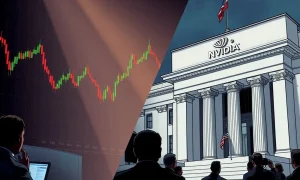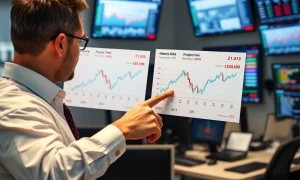Jeremy Siegel, a highly respected Wharton professor, has declared: “The die is cast.” He refers to an impending Fed rate cut. Markets widely anticipate this significant shift. Federal Reserve Chair Jerome Powell also recognizes this inevitable policy adjustment. This signals a crucial turning point for the global economy. Investors and businesses alike are now closely watching for this development.
The Imminent Fed Rate Cut: Siegel’s Conviction
Siegel’s argument rests on observable economic trends. He points to consistent disinflation. Both the Consumer Price Index (CPI) and Producer Price Index (PPI) show cooling trends. Therefore, inflationary pressures appear to be easing. This reduction in inflation lessens the need for restrictive monetary policies. Consequently, the Federal Reserve gains flexibility.
Moreover, the labor market exhibits signs of moderation. While still robust, wage growth is slowing. This further reduces potential inflationary impulses. Such conditions provide the Fed with more room to maneuver. They can consider a Fed rate cut without reigniting inflation. Markets, in turn, often price in future expectations. Current bond yields reflect a strong anticipation of lower interest rates. This market behavior reinforces the conviction in a coming Fed rate cut.
Siegel emphasizes that the Fed’s past actions were appropriate. However, he believes the current economic landscape calls for a pivot. Maintaining high rates for too long risks an unnecessary economic slowdown. Thus, a proactive adjustment is becoming essential.
Understanding the Federal Reserve’s Evolving Stance
Federal Reserve Chair Jerome Powell’s recent public statements echo a cautious optimism. He consistently highlights progress on inflation. Nevertheless, he stresses the Fed’s data-dependent approach. The central bank aims for a “soft landing.” This means reducing inflation without triggering a severe recession. Policy adjustments are therefore critical in achieving this balance.
The Federal Reserve operates under a dual mandate. It strives for both maximum employment and price stability. As inflation cools towards its 2% target, the focus can gradually shift. Supporting sustainable economic growth becomes a higher priority. This strategic shift paves the way for a potential Fed rate cut. Policymakers meticulously analyze various economic indicators. They scrutinize employment figures, inflation reports, and global economic conditions. Their decisions are deliberate and carefully considered.
Key indicators the Fed monitors include:
- Inflation Data: CPI, PPI, and Personal Consumption Expenditures (PCE) index.
- Employment Statistics: Job growth, unemployment rate, wage increases.
- Economic Growth: GDP figures and business investment.
- Global Economic Conditions: International trade and geopolitical events.
Ultimately, the Fed seeks to achieve its objectives. It wants to maintain a stable and prosperous economy. A strategic Fed rate cut serves this overarching goal.
Why a Fed Rate Cut Matters for the Economy
A Fed rate cut has widespread economic implications. Firstly, it directly lowers borrowing costs. Mortgages, car loans, and business credit become more affordable. This encourages both consumer spending and business investment. Consequently, economic activity typically receives a boost.
Secondly, stock markets often react positively. Lower interest rates make future corporate earnings more valuable. They also encourage capital to move from bonds to equities. This rebalancing can significantly boost stock prices. Companies might also find it cheaper to borrow for expansion. This fuels further growth.
Thirdly, bond yields generally fall. Existing bonds, especially those with higher yields, become more attractive. This can generate capital gains for current bondholders. New bond issues, however, will offer lower returns. Investors seeking yield might look elsewhere.
Finally, the U.S. dollar might weaken. Lower interest rates reduce the appeal of dollar-denominated assets. This makes U.S. exports more competitive internationally. Conversely, imports become more expensive. This shift can influence trade balances. Therefore, a Fed rate cut impacts many facets of the economy.
Navigating the Market Shift After a Fed Rate Cut
Investors should carefully review their portfolios. Different market sectors react uniquely to a Fed rate cut. Growth stocks, for instance, often perform well. Their future earnings are discounted at a lower rate. This increases their present value. Technology and innovation-driven companies frequently fall into this category.
Conversely, value stocks might see less immediate impact. These are often mature companies with stable earnings. Financial sectors, however, could face mixed results. Lower rates might compress net interest margins for banks. Real estate generally benefits from lower mortgage rates. This stimulates housing demand and property values. Property investment becomes more accessible.
However, market volatility remains a factor. Markets price in expectations rapidly. The actual announcement of a Fed rate cut can lead to short-term fluctuations. Investors should anticipate some turbulence. Diversification remains a crucial strategy. Spreading investments across various asset classes mitigates risk. Consider consulting financial advisors for personalized strategies. They can help align investments with individual risk tolerance and financial goals.
Historical Precedents for a Fed Rate Cut
The Federal Reserve has a long history of adjusting interest rates. These adjustments respond to changing economic conditions. Past cycles show a clear pattern. The Fed raises rates to curb inflation. Then, it cuts rates to support economic growth during slowdowns. These historical movements provide valuable context.
For example, after the dot-com bubble burst in the early 2000s, the Fed cut rates significantly. This action helped stabilize the economy. Similarly, following the 2008 financial crisis, rates dropped to near zero. These drastic cuts aimed to stimulate lending and investment. Such measures were vital for recovery. While each economic cycle is unique, historical patterns offer insights. They suggest the Fed prioritizes overall economic stability. A Fed rate cut is a standard tool in its policy toolkit. It uses this tool to manage economic cycles effectively.
Notable historical instances include:
- Early 2000s: Rate cuts following the dot-com bust.
- 2008-2009: Aggressive cuts during the financial crisis.
- 2019: Mid-cycle adjustments to counter global slowdowns.
- 2020: Emergency cuts during the COVID-19 pandemic.
These examples underscore the Fed’s willingness to act. It adjusts policy to support economic health.
Global Implications of a Fed Rate Cut
The U.S. economy profoundly influences global markets. Therefore, a Fed rate cut in the U.S. has significant international repercussions. Other central banks might consider similar policy adjustments. This can lead to a synchronized easing of global monetary policy. Such coordination can stimulate worldwide economic activity.
Emerging markets could experience increased capital inflows. Lower U.S. interest rates make these markets more attractive. Investors seek higher returns. This influx of capital can strengthen their currencies. It can also boost their local stock markets. Conversely, a weaker dollar can impact commodity prices. Many commodities are priced in U.S. dollars. A weaker dollar often boosts their value. This affects global trade and inflation for importing nations. International trade balances could also shift. Cheaper U.S. exports become more competitive. This benefits American producers. However, it makes imports more expensive for U.S. consumers. Thus, the ripple effects of a U.S. Fed rate cut extend globally.
Jeremy Siegel’s assertion holds considerable weight. The consensus among market participants points towards an inevitable Fed rate cut. This move reflects changing economic conditions. It also marks a strategic pivot by the Federal Reserve. Investors, businesses, and consumers must prepare for this pivotal adjustment. The global economy will undoubtedly feel its widespread ripple effects. Understanding these dynamics is crucial for navigating the evolving financial landscape.
Frequently Asked Questions (FAQs)
What is a Fed rate cut?
A Fed rate cut refers to the Federal Reserve lowering its benchmark interest rate, the federal funds rate. This rate influences other interest rates throughout the economy, including those for loans, mortgages, and savings accounts. Lowering it makes borrowing cheaper and encourages economic activity.
Why is Jeremy Siegel confident about a Fed rate cut?
Jeremy Siegel’s confidence stems from persistent signs of disinflation, particularly in CPI and PPI data. He also notes a moderating labor market. These trends suggest the Fed’s restrictive policies have succeeded in cooling inflation, thus paving the way for a policy easing.
How does a Fed rate cut affect the stock market?
A Fed rate cut generally has a positive impact on the stock market. Lower interest rates make borrowing cheaper for companies, potentially boosting their profits. They also make future earnings more valuable and encourage investors to shift capital from lower-yielding bonds to equities, driving up stock prices.
What are the risks associated with a Fed rate cut?
While generally positive, risks exist. A premature Fed rate cut could reignite inflation if disinflationary trends are not sustained. Conversely, delaying a necessary cut could lead to an economic slowdown or recession. Market volatility is also common around such policy shifts.
When is the next Fed rate cut expected?
The exact timing of the next Fed rate cut remains uncertain and data-dependent. However, market expectations and many analysts point to a potential cut occurring in mid-2024, assuming inflation continues its downward trend and economic growth moderates.
How does a Fed rate cut impact everyday consumers?
For everyday consumers, a Fed rate cut can mean lower interest rates on variable-rate mortgages, credit cards, and car loans, making borrowing more affordable. It can also lead to lower returns on savings accounts and certificates of deposit (CDs), prompting some to seek higher returns elsewhere.








